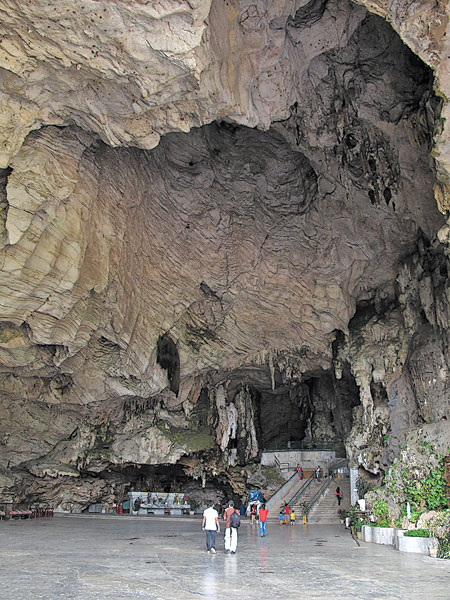A big Chinatown
Updated: 2012-08-30 09:43
By Wang Kaihao (China Daily)
|
||||||||
 |
|
Sam Poh Tong is a popular temple named after 14th century former Chinese admiral Zheng He. |
 |
|
Kek Lok Tong temple is in a limestone cave. |
There are about 100 caves around Ipoh, which explains why the city is also known as "Little Guilin", after the celebrated karst landform area in China's Guangxi Zhuang autonomous region.
My trip continues 60 km north of Ipoh to explore the origins of Cantonese immigrants to Taiping, which means "peace" in Chinese. The town was the first entry point to Peninsula Malaysia before they settled down in other parts of the country.
The ride is scenic and relaxing - I feast my eyes on rustic yet beautiful Malay kampung houses followed by glittering mosques with colorful minarets and palaces. I cannot help but ask the driver to stop a few times along the way so that I can record the panoramic view with my camera.
Unfortunately, by the time I reach Taiping, it is too late to enter the famous botanic gardens. I only managed to marvel at the rain trees, with branches extending across the road, outside the garden walls.
A quick tour of the town gives me the impression that Taiping is a smaller version of Ipoh. Most of the 200,000 local residents are Chinese.
The city feels serene like its name but our guide tells us that Taiping has a glorious past - it was the former state capital of Perak before 1937, and the British authority even considered making it the capital of Malaya (colonial name for Peninsula Malaysia) before they chose Kuala Lumpur.
Taiping also boasts of the first general hospital and railroad in the peninsula.
Passing by a busy market, I notice one corner where there are hand-drawn grids on the ground. Apparently, according to the guide, during his childhood days, people would gather around the grid lines to bet on which block would have the first rain drop of the day. Taiping has the heaviest precipitation in Malaysia, and it rains almost every afternoon.
"People are too busy now for such an activity," he sighs.
To me, the pace of the town is a lot slower than any I have witnessed so far.
I arrive in a Chinese fishing village called Kuala Sepetang (Kuala means "estuary" in Malay and Sepetang means "18 men" in Cantonese) late in the afternoon.
I treat myself to dinner at a seafood restaurant on the upper floor of a pier overlooking the estuary leading to the Indian Ocean. I spend only about RM30 ($9.60) for a banquet of fresh seafood, with the most beautiful sunset I have ever seen, against the backdrop of boundless mangrove forests.
Fishing boats shuttle in and out of the port, while some boats carry devotees who are out praying to the gods of the sea. On the other side of the restaurant, I also see children swimming happily in a river.
It is difficult to imagine this small village was once one of the busiest ports in Malaya.
Contact the writer at wangkaihao@chinadaily.com.cn.

 'Taken 2' grabs movie box office crown
'Taken 2' grabs movie box office crown
 Rihanna's 'Diamonds' tops UK pop chart
Rihanna's 'Diamonds' tops UK pop chart
 Fans get look at vintage Rolling Stones
Fans get look at vintage Rolling Stones
 Celebrities attend Power of Women event
Celebrities attend Power of Women event
 Ang Lee breaks 'every rule' to make unlikely new Life of Pi film
Ang Lee breaks 'every rule' to make unlikely new Life of Pi film
 Rihanna almost thrown out of nightclub
Rihanna almost thrown out of nightclub
 'Dark Knight' wins weekend box office
'Dark Knight' wins weekend box office
 'Total Recall' stars gather in Beverly Hills
'Total Recall' stars gather in Beverly Hills
Most Viewed
Editor's Picks

|

|

|

|

|

|
Today's Top News
Health new priority for quake zone
Xi meets US top military officer
Japan's boats driven out of Diaoyu
China mulls online shopping legislation
Bird flu death toll rises to 22
Putin appoints new ambassador to China
Japanese ships blocked from Diaoyu Islands
Inspired by Guan, more Chinese pick up golf
US Weekly

|

|






